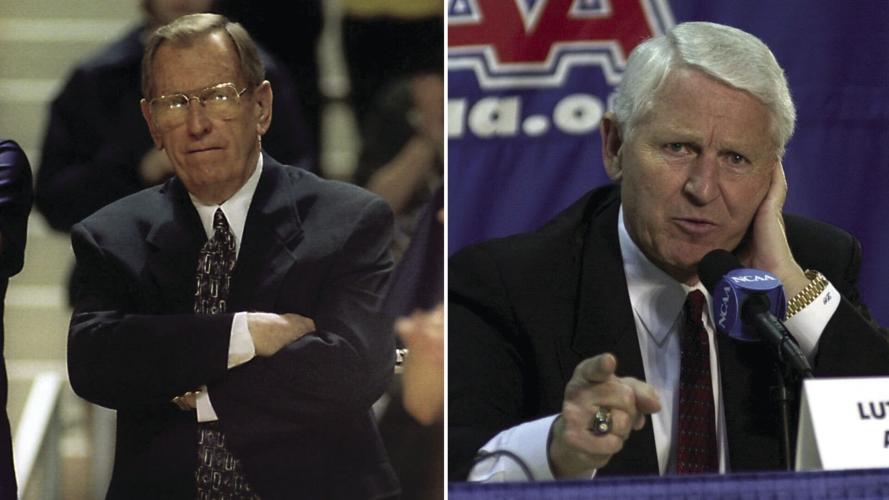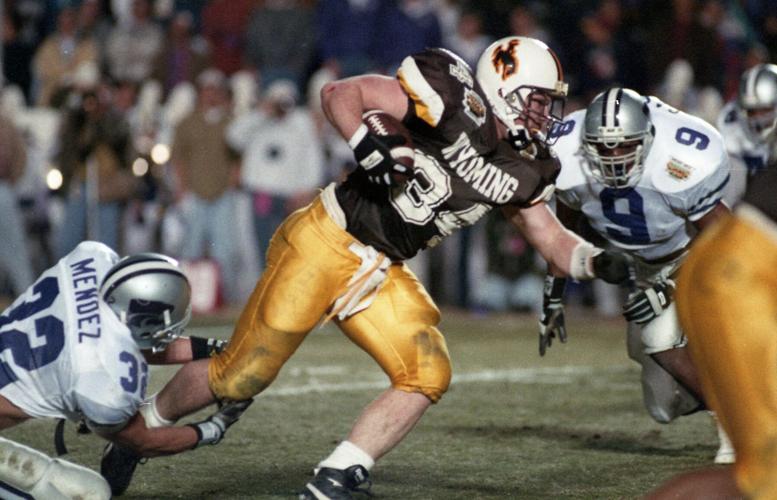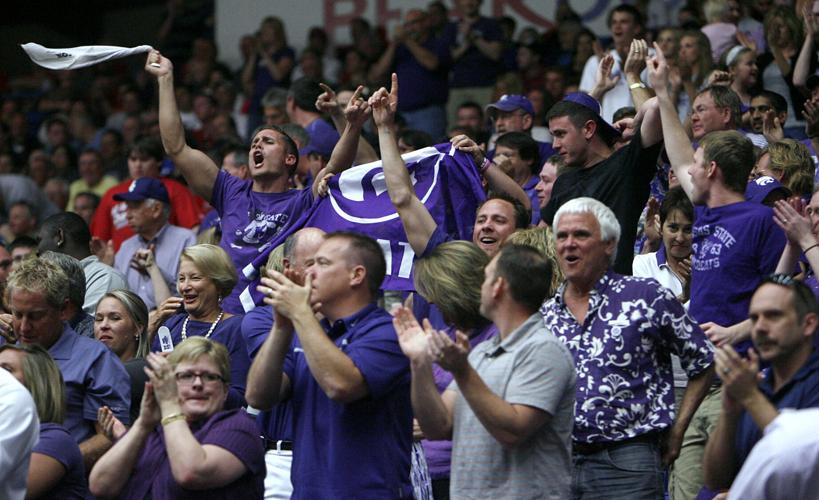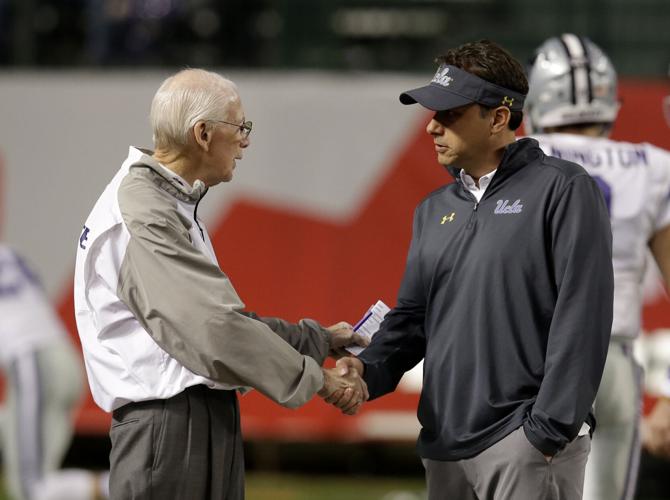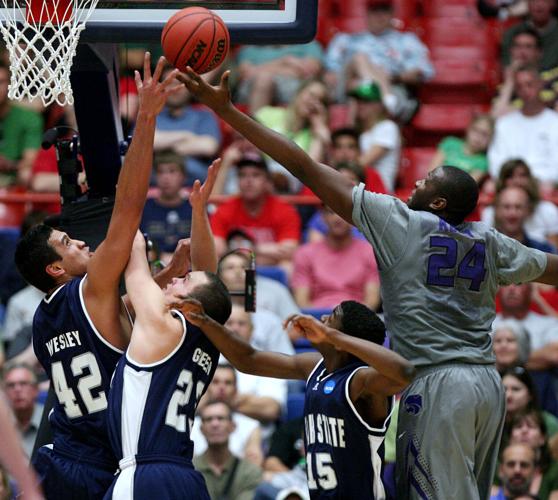Editor’s note: This story marked the kickoff of the Star’s Summer “Big 12 Blitz” series, where we introduced U of A fans to the on- and off-field need-to-know details surrounding each member of the 16-team Big 12 Conference. Up first was Kansas State University, located in Manhattan, Kansas.
The Star's Big 12 Blitz is presented by Tucson Appliance Company.

Tucson Appliance Company has something for everyone! We specialize in new, reconditioned, scratch-and-dent, and high-end appliances. Known for…

Greg Hansen is the longtime sports columnist for the Arizona Daily Star and Tucson.com.
Perhaps the most important day in UA sports history was March 31, 1982.
That’s no April Fool’s Day Eve joke.
It was the day Kansas State basketball coach Jack Hartman told Arizona athletic director Dave Strack that, yes, he would replace Fred Snowden as the UA’s basketball coach.

Longtime successful Kansas State basketball coach Jack Hartman was supposedly a step away from taking the Arizona head coaching job back in 1982, but eventually turned it down. The next year, Arizona went 4-24 under Ben Lindsey, leading to the hiring of eventual national championship-winning coach Lute Olson in 1983. Had Hartman taken the job in Tucson, the futures of both programs could have ended up so, so different.
Imagine what that would have meant. Foremost, it meant that Iowa coach Lute Olson would not have become Arizona’s coach a year later, the single most compelling and impactful transaction in UA sports history.
Thanks to 'Big 12 Blitz' presenting partner Tucson Appliance Company, Kansas State insider Tim Fitzgerald, publisher of GoPowercat.com, helps us get to know those other Wildcats from Manhattan, Kansas, while making his hot spot recommendations for Aggieville, six blocks of restaurants, bars and other things to do near KSU's campus.
On that spring night in 1982, Strack went to bed thinking that hiring Kansas State’s coach, coming off back-to-back appearances in the Elite Eight and Sweet 16, would be the coup of Strack’s career. Hartman would surely resuscitate the anguishing nose-dive taken by Snowden’s once-proud basketball program.
Here’s what Strack told the Daily Star:
“At one time, (Hartman) indicated to us he’d be our coach. Then, within five or 10 minutes, he called back and said that he had reflected further and decided against coming here.’’
Strack’s killer line: “Jack told me, ‘yes, I’m not coming.’ ‘’
At the time, getting rejected by Kansas State’s coach felt like an enormous loss. Strack pivoted to Plan B and hired Grand Canyon coach Ben Lindsey, which was an unmitigated disaster. Lindsey went 4-24 and was fired after one season.
That’s when new athletic director Cedric Dempsey took the bold step of offering Olson the Arizona job. The rest is history. The image and reputation of Arizona sports — of Tucson itself — climbed to unprecedented heights.

Legendary now-retired Kansas State football coach Bill Snyder met a Jedd Fisch-coached team once — on Dec. 26, 2017, in the Cactus Bowl at Chase Field in Phoenix. Fisch was the interim head coach for UCLA that night, while Snyder was leading his Wildcats in what would be his final bowl game as a college head coach. KSU won, 35-17 over Fisch's Bruins. While Fisch, who would coach at Arizona from 2021-2023 before leaving to helm the Washington Huskies this past offseason, won't be on the sidelines when the UA faces KSU in Manhattan, Kansas, in September, the game will be played Bill Snyder Family Stadium, named for the man who brought the KSU program to national prominence.
All because the Kansas State coach said no.
The Arizona-Kansas State relationship goes much deeper than swapping Jack Hartman for Lute Olson, or sharing the nickname Wildcats. When the two schools open competition as Big 12 rivals this fall, there will be some notable shared history.
Arizona head football coaches Jim LaRue (1959-66) and Mike Stoops (2004-11) both climbed the coaching ladder as assistants at KSU in the 1950s and 1990s, respectively.
In 1951, Arizona played its first-ever NCAA basketball tournament game against Kansas State. The UA’s 24-4 Wildcats had climbed to their highest-ever ranking in the AP poll, at No. 12. Alas, they lost to KSU’s No. 4-ranked Wildcats 61-59 in Kansas City, which would propel Kansas State to the Final Four championship game ( a loss to Kentucky).
Some at KSU might say their biggest triumph on the Arizona campus came on a chilly December night, 1992, when the Wildcats from Manhattan, Kansas, routed Wyoming 52-17 in the Copper Bowl. The game drew 49,075, the largest crowd in the 11-year existence of Tucson’s bowl game.

Kansas State defenders collapse on a University of Wyoming back during the 1993 Copper Bowl at Arizona Stadium in Tucson. That game on the UA campus was the first bowl game (and bowl win) of Bill Snyder’s long Kansas State coaching tenure. Over two stints (27 total coaching seasons), Snyder took what was considered the worst program in the country and won at least nine games 14 times, 10 or more wins nine times, and 11 wins six different seasons, including four straight 11-win seasons from 1997-2000.
It was estimated that about 25,000 Kansas State fans traveled to Tucson for that game, which raised a few eyeballs in Tucson and elsewhere in college football. Why would anyone follow Kansas State?
Remember Sports Illustrated’s infamous 1989 story in which it referred to KSU as “Futility U’’? SI wrote: “It is America’s most hapless team.’’
Indeed, in 1989, over 93 years, KSU had the worst cumulative record of the then-106 Division I football teams at 299-509-41. It had gone 4-50-1 the previous five seasons.
And then it all changed.
After beating Wyoming at Arizona Stadium, the Wildcats, under new coach Bill Snyder — the Lute Olson of KSU athletics history — went 81-17-1 from 1993-2000. People talk about Nick Saban being the greatest-this and greatest-that in college football history, but it’s unlikely even Saban could’ve turned KSU into a consistent Top 25 program the last 32 years.
In that eight-year period, KSU won 11 games four seasons in a row: 11-1, 11-2, 11-1 and 11-3. Compare that to Arizona, which has won 11 (or more) games in a season just once, 1998.

Kansas State's Curtis Kelly (far right) reaches over Utah State's Tai Wesley, Brian Green and James Walker for a rebound during the Wildcats' 73-68 win over the Aggies to open the 2011 NCAA Men's Basketball Tournament play for both teams at McKale Center on March 17, 2011.
Kansas State is now considered a football school, a Top 25 program. When Arizona pursued KSU’s basketball coach in 1982, it was decidedly a basketball school.
The most anticipated Arizona-Kansas State sporting event was surely a 1941 football showdown at Arizona Stadium. UA athletic director Pop McKale, weary of the weak competition in the Border Conference, made a determined move to upgrade the UA’s schedule. He not only added Kansas State, McKale agreed to open the ’41 season at Notre Dame (losing 38-7 in Frank Leahy’s first game as Irish coach).
McKale earlier added then-mighty Minnesota, losing 62-0 in 1939, and powerhouse SMU, losing 29-7 in 1938.
Playing Kansas State in Tucson was considered a significant step up. The Daily Star referred to KSU as “big, bruising Kansas State, conqueror of Nebraska’s famed Cornhuskers.’’
But eight days before the Japanese bombed Pearl Harbor, Arizona upset Kansas State 28-21 before a capacity crowd of 9,000 at Arizona Stadium. It was, in 1941, one of the two or three most significant victories in UA football history. The newspaper referred to it as “a thrill-packed game.’’

From the 1993 Copper Bowl at Arizona Stadium to the 2011 NCAA Tournament at McKale Center, the Kansas State Wildcats and their fans felt at home in Tucson on multiple postseason occasions. Pictured, KSU fans cheer as their Wildcats rally in the second half to before falling to fourth-seeded Wisconsin 70-65 on March 19, 2011, at McKale in the Round of 32. Fifth-seeded KSU defeated 12th-seeded Utah State 73-68 to open tournament play in Tucson two days earlier.
Before that 1941 showdown, Tucsonans treated Kansas State with considerable respect. When KSU got off the train in downtown Tucson, all 31 of its players were presented Mexican sombreros. A group of stagecoaches then shuttled the KSU Wildcats to the downtown Santa Rita Hotel.
When Arizona arrives in Kansas on Sept. 13 to ignite a new generation of sports competition between the new Big 12 partners, don’t expect a warm greeting at Bill Snyder Stadium. No sombreros. No escort to the team hotel.
Futility U has left the building.
Arizona and UCF football square off Nov. 2 in the "Space Game." UCF, known as "Space U" for its setting and impact on NASA and nearby Kennedy Space Center, has played its way into becoming Orlando's home town team.


